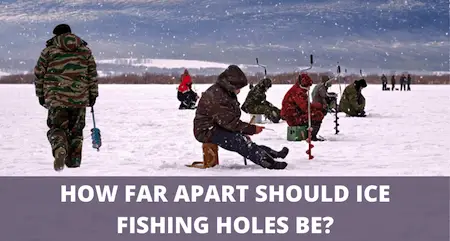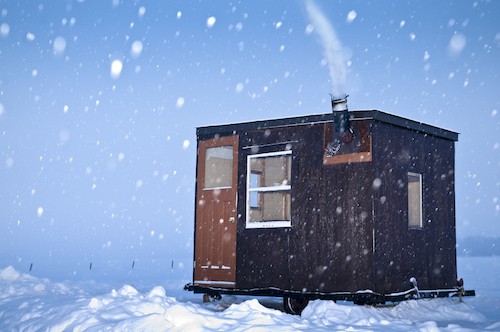What Is The Ideal Spacing Between Ice Fishing Holes?
UPDATED 18 MAY 2023
by Robert Ceran
A question I’m asked a lot is: how far apart should you space ice fishing holes?
Here’s the quick answer:
If you’re fishing next to someone else on the ice, your holes should be at least 5-6 feet apart to avoid fish getting tangled in each other’s lines when you pull them up.
If you’re using a camera for ice fishing, the hole for the camera should be at least 2 feet away from your fishing hole.
This is close enough to see your lure with the camera, while minimizing the risk of fish getting tangled in the camera line when you pull them up.

Ice fishing requires drilling a hole through the ice in order to catch fish.
If you’re already an ice angler, or have done a little research on the topic, you probably know that most ice anglers drill more than one hole during a day of ice fishing, which raises the question of how far apart you should space those holes.
Let’s look at why correct spacing of ice fishing holes is important, and what the ideal spacing should be for different scenarios.
Why is optimal spacing between ice fishing holes important?
There are two main reasons why spacing ice holes correctly is important:
- To avoid entanglement of your fishing tackle or your camera wire between two holes.
- To avoid safety hazards.
The first reason for spacing holes far enough apart is to avoid entanglement of fishing tackle from two ice holes next to each other, which is especially critical after hooking a fish that can pull away sideways under the ice while you’re trying to pull it up.
This can become a real problem when you hook a big fish that fights hard.
This kind of entanglement is unfortunately quite common, and even small fish like sunfish or bluegills can get entangled with the line from a neighboring hole, or with the line of your fishing camera.
If you hook a big pike, walleye, or lake trout, the risk of getting entangled goes up exponentially, since they’re a lot stronger and harder to control.
So, in order to avoid getting tangled up with your neighbor, try to space adjacent ice fishing holes as far apart as possible.
If you’re fishing with tip ups, it’s better to space them out anyways, instead of bunching them all up in the same place.
The second reason for spacing holes correctly is to avoid safety hazards. Every hole poses a risk of stepping into it by mistake, which can easily happen if you’re moving around while distracted by something else.
If you’ve chosen the correct size of your ice fishing hole, it will very rarely be bigger than 8 or 10 inches, which means an adult can’t actually fall through the hole.
For more information on choosing the correct hole size, check out or article on how big should an ice fishing hole be.
While there’s little danger of falling through a normal sized ice hole, stepping into one can still trip you up, resulting in a painful fall on the ice.
So if someone has covered an area with many ice holes spaced closely together, you’ll need to move very carefully to avoid stepping into them.
To reduce the risk of stepping into ice holes, try to drill as few as possible, and mark them in some way so they are easier to avoid.
How far apart should ice fishing holes be?
Let’s take a look at the different reasons for drilling more than one hole in the ice:
- You want to test different locations, in order to find the best fishing spots.
- You want to set up more than one rod for ice fishing, thereby covering several locations at the same time and increasing your chances of catching fish.
- You want to fish next to your buddies.
- You want to fish together with several people in one ice shanty.
- You want to use a separate hole for a flasher or fish finder.
- You want to use a separate hole for an ice fishing camera.
Each of these cases is slightly different, and requires a somewhat different spacing of the holes.
If you’re testing different locations, or setting up several ice rods for deadsticking, you’ll want to spread them out quite far from each other, and I suggest keeping them at least 10 feet apart.
If you’re fishing next to another angler, try to keep your ice holes at least 5-6 feet apart from each other. If one of you hooks a fish, this distance is usually far enough to avoid entanglement.
In case you hook a really big fish, you can also ask your neighbors to pull up their tackle until you safely land it on the ice.
Optimal spacing of holes inside an ice shanty

If you’re fishing together with several people inside an ice house or shanty , it’s unfortunately not possible to maintain 5-6 foot spacing between holes, since ice houses are small by nature.
However, you should still aim to keep as much distance as possible between holes, and don’t put them closer together than 2 feet apart.
Also, if you don’t use all the holes in an ice house, cover them up with a piece of wood to avoid stepping into them.
And if one of you hooks a larger fish, it’s best if the others pull up their gear until the fish is safely landed.
Optimal spacing of holes if you’re using a flasher
If you’re using a flasher (such as a Vexilar or Marcum) to locate fish, the best way to do this is to danlge the transducer in the same hole that you’re fishing in.
That way you avoid having to drill a second hole, plus it will give you a more accurate picture of what’s going on, since the transducer is positioned vertically above your lure.
Transducers are not really at risk of entanglement anyways, since they are only submerged to the bottom edge of the ice, and you can easily pull them out of the ice when you’re landing a fish.
Optimal spacing of holes if you’re using an ice fishing camera
Unlike a flasher transducer, an underwater camera for ice fishing needs to be lowered down to the same level as your lure, and it needs to be close enough to the lure to view it and any fish that swim close to it.
This poses a real challenge, because that kind of proximity greatly increases the risk of entanglement.
In order to minimize the risk of getting entangled with the camera wire, try to space the camera hole 2-3 feet away from your fishing hole.
That distance is still close enough to be able to view your fishing lure plus potential fish marking it, while being far enough away from it to avoid getting entangled every time you hook a fish.
Final remarks
In general, try to drill as few holes as possible, and space them as far apart as possible.
In situations where that isn’t possible, be aware of the entanglement risks, and be prepared to deal with them.
Finally, when you go home, remember to mark your holes so that other anglers don’t step into them.
